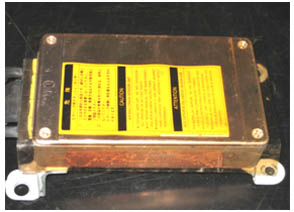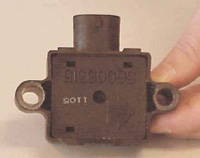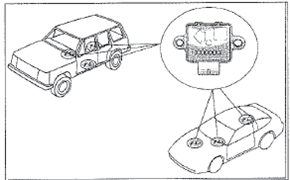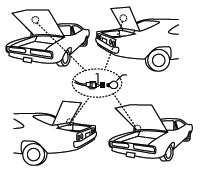|
|||||||||
|
|||||||||
|
|
|
|
|
|
|
|
|
|
|
|
|
|
|
|
|
Automobiles
Jump To:
Air Bag Crash Sensors | ABS Switches | Convenience Light Switches | General References
Air Bag Crash Sensors
Description: An air bag is a flexible membrane or envelope that rapidly inflates during an automobile collision so as to cushion the impact. The air bag system includes a crash sensor module that deploys the airbag upon impact. A limited number of older vehicles (pre-1994) contained mercury switches in the crash sensor module. Each vehicle had one crash sensor module typically containing two mercury switches. The air bag crash sensor modules were commonly located under the center console on the drive line tunnel, on the floor pan below the driver's seat, or behind the glove box.
Purpose of the Mercury: The mercury switches located in the air bag crash sensor module conduct electricity, which triggers the air bag to inflate upon collision.
 |
| Source: End of Life Vehicle Solutions (ELVS), (mercury-containing air bag crash sensor module) |
Potential Hazards: As long as the vehicle remains intact, there is a low probability that there would be a mercury release. However, if the mercury switch is not removed prior to the vehicle being shredded at a scrap metal recycler, the mercury switch becomes compromised and mercury can be released to the environment.
Note: air bag inflation units also contain pyrotechnic devices that inflate the air bag during a crash. Removing them requires special training, and they are not part of the vehicle mercury switch recovery program. Only the air bag crash sensor modules, which contain a mercury switch, should be removed.
Recycling/Disposal: End-of-Life Vehicle Solutions Corporation (ELVS) has set up a nationwide program designed to encourage the proper removal and disposal of mercury switches, including air bag sensors, from automobiles (except in Maine, which has a separate program). Participating automobile dismantlers can remove the mercury switches and send them for proper recycling and disposal, all expenses paid. In states where there is no mandatory switch removal legislation, a financial incentive is provided through the National Vehicle Mercury Switch Recovery Program (NVMSRP).
Links to additional instructions or other sources of information may be found in the "General References" section at the bottom of the page.
Statutes and Other Information: A limited number of automobile manufacturers used mercury acceleration sensors for air bags crash systems in some vehicles during the model year period of 1984-1993. Vehicles manufactured after this timeframe do not contain a mercury switch.
Maine and New York prohibit the sale of new automobiles that contain any type of mercury switch – including those found in air bag crash sensors. Other states, including Illinois, Massachusetts, Minnesota, North Carolina, and Rhode Island, do not specifically identify mercury switches found in air bag crash sensors as prohibited, but do require all mercury switches to be removed from end-of-life vehicles prior to crushing, shredding, and smelting the vehicle for disposal. Maine and New York also have this requirement.
Related Link:
http://elvsolutions.org/?page_id=591
http://elvsolutions.org/?page_id=701
Anti-Lock Brake Systems (ABS)
Description: Anti-lock brake systems (ABS) in automobiles prevents the wheels from locking while braking, allowing the driver more control during a skid. A typical ABS is composed of a central electronic unit, up to four sensors (G-force), and two or more hydraulic valves on the brake circuit. In some vehicles manufactured prior to 2004, mercury switches were located in the G-force sensors. Each of these G-force sensors contained two to three mercury switches embedded in plastic and were located in the drive tunnel; below the rear seat on the floor pan; and on the left frame rail, directly below the driver.
Purpose of the Mercury: The G-force sensor in a vehicle's anti-lock brake system detects deceleration and takes the vehicle out of 4-wheel drive during slipping, thus preventing an out-of-control skid. The mercury switches located in the ABS G-force sensor conduct electricity in the brake circuit.
 |
| Click image for a larger view Source: Maine Dept. of Environmental Protection, (mercury g-force sensor) |
Potential Hazards: As long as the vehicle remains intact, there is a low probability that there would be a mercury release. However, if the mercury switch is not removed prior to the vehicle being shredded at a scrap metal recycler or crushed in a landfill, the mercury switch becomes compromised and mercury can be released to the environment.
Recycling/Disposal: End-of-Life Vehicle Solutions Corporation (ELVS) has set up a nationwide program designed to encourage the proper removal and disposal of mercury switches, including anti-lock brake systems, from automobiles (except in Maine, which has a separate program). Participating automobile dismantlers can remove the mercury switches and send them for proper recycling and disposal, all expenses paid. In states where there is no mandatory switch removal legislation, a financial incentive is provided through the National Vehicle Mercury Switch Recovery Program (NVMSRP).
The ABS speed sensors located in wheel units do not contain mercury and do not need to be removed prior to disposal. Only the ABS control modules that contain a G-force sensor with a mercury switch should be removed.
 |
| Source: Maine Dept. of Environmental Protection, (location of mercury anti-lock brake g-force sensors) |
Links to additional instructions or other sources of information may be found in the "General References" section at the bottom of the page.
Statutes and Other Information: Many automobiles manufactured prior to 2003 contained mercury switches in the anti-lock brake system. However, not all vehicles with ABS G-force sensors contained mercury switches – some manufacturers never used mercury switches and others phased-out mercury switches in the mid-1990s. The use of mercury switches in anti-lock brake systems was phased-out of all vehicles as of model year 2004.
Many states, including Maine, Massachusetts, New York, and Washington prohibit the sale of new automobiles that contain mercury switches in their anti-lock brake systems (ABS). Other states, including Illinois, Maine, Massachusetts, Minnesota, North Carolina, Rhode Island, require the mercury switches to be removed from end-of-life vehicles prior to crushing, shredding, and smelting the vehicle for disposal.
Related Link:
http://elvsolutions.org/?page_id=1489
Convenience Light Switches
Description: Most cars have lights located in or near the ceiling of the passenger compartment, and in the hood, trunk, and other locations, to provide illumination. These "convenience lights" often have an option to switch on when the doors, hood, or trunk of the vehicle are opened, and many of the automobiles manufactured prior to 2003 contain a mercury switch to do this. The mercury light switches were typically located in the hood or trunk convenience lighting system, although a limited number of cars may also include them in the vanity mirrors (e.g., Volvo).
There is also anecdotal evidence that some cars included convenience lighting systems in the engine compartment, glove box, and other storage compartments; however specific manufacturers or models with this have not been identified.
Purpose of the Mercury: The mercury switch in the convenience light system is used to conduct electricity. For example, when the trunk or hood of a vehicle is opened, the mercury switch turns the light "on."
 |
| Source: Maine Dept. of Environmental Protection, (mercury auto light switch) |
Potential Hazards: As long as the vehicle remains intact, there is a low probability that there would be a mercury release. The mercury switches commonly found in vehicles are encased in metal and are not likely to leak or break. However, a limited number of car manufacturers had some models with convenience light systems in engines, luggage compartments, and vanity mirrors that included mercury switches encased in a glass ampoule, which is more susceptible to breaking.
It is important not to mix these glass ampoules with the metal switches in the same container because if the glass breaks and mercury is released, the entire container of switches will be contaminated and must be managed as hazardous waste. Regardless of the type of mercury switch (metal or glass), if it is not removed prior to the vehicle being shredded at a scrap metal recycler or crushed in a landfill, the switch becomes compromised and mercury can be released to the environment.
Recycling/Disposal: End-of-Life Vehicle Solutions Corporation (ELVS) has set up a nationwide program designed to encourage the proper removal and disposal of mercury switches, including those in the convenience lighting systems, from automobiles (except in Maine, which has a separate program). Participating automobile dismantlers can remove the mercury switches and send them for proper recycling and disposal, all expenses paid. In states where there is no mandatory switch removal legislation, a financial incentive is provided through the National Vehicle Mercury Switch Recovery Program (NVMSRP).
 |
| Source: Maine Dept. of Environmental Protection, (location of mercury convenience light switch) |
Links to additional instructions or other sources of information may be found in the "General References" section at the bottom of the page.
Statutes and Other Information: Many U.S. made automobiles manufactured prior to 2003 contained mercury switches in the convenience lighting systems noted above. The use of mercury switches in convenience lights ended for all automobiles beginning with model year 2003.
Many states, including California, Maine, Massachusetts, New York, Oregon, and Washington prohibit the sale of new automobiles that contain mercury light switches. Other states, including Illinois, Maine, Massachusetts, Minnesota, North Carolina, Rhode Island, require the mercury switches to be removed from end-of-life vehicles prior to crushing, shredding, and smelting the vehicle for disposal.
Related Link:
http://elvsolutions.org/?page_id=1298
http://elvsolutions.org/?page_id=542
General References
The links below are general references that provide information pertaining to all mercury-containing switches and other mercury components found in automobiles:
General Information about Mercury in Automobiles:
https://www.epa.gov/mercury/mercury-consumer-products#list
http://www.mass.gov/eea/docs/dep/service/regulations/310cmr74.pdf
Automobile Mercury Switch Removal Initiatives:
http://www.maine.gov/dep/waste/motorvehiclerecycling/index.html
http://www.lhwmp.org/home/publications/publications_detail.aspx?DocID=dRXCj88Bs3A%3d
Instructions for Vehicle Mercury Switch Removal and Disposal:
http://www.maine.gov/dep/mercury/documents/guidancemanual0608.pdf
Mercury Product Phase-outs, Sales Prohibitions, and Exemptions:
http://www.newmoa.org/prevention/mercury/imerc/banphaseout.cfm
Last Modified 08/25/2020
Home
|
Pollution Prevention
|
Mercury
|
IMERC
|
Solid Waste
Hazardous Waste
|
Waste Site Cleanup
|
About NEWMOA
|
NEWMOA Members
Copyright 2025 NEWMOA, Northeast Waste Management Officials' Association
89 South Street, Suite 600; Boston, MA 02111-2651;
ph (617) 367-8558
fax (617) 367-0449
TDD/TTY (857) 265-3934
All Rights Reserved
Comments contact:
.
